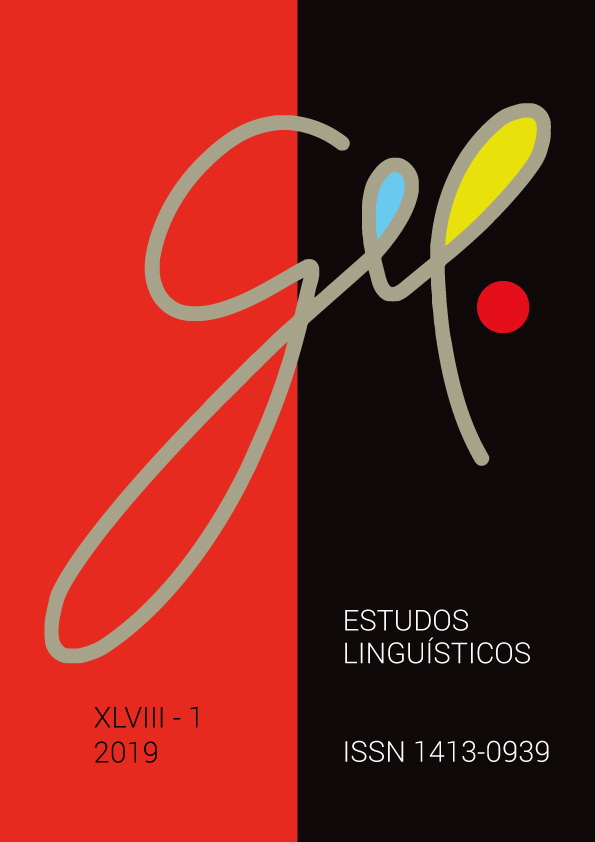A coocorrência de elementos modais em obras de autoajuda dirigidas a mulheres
DOI:
https://doi.org/10.21165/el.v48i1.2280Parole chiave:
modalidade, coocorrência modal, discurso de autoajudaAbstract
Considerando a modalidade como uma forma de manifestação da atitude do enunciador frente ao enunciado produzido, este trabalho propõe-se a analisar, dentro de uma abordagem funcionalista da linguagem, os efeitos de sentido produzidos pela coocorrência de elementos modalizadores em obras de autoajuda dirigidas às mulheres com o objetivo de verificar em que medida os valores iguais ou diferentes desses elementos contribuem para reforçar ou atenuar um determinado efeito de sentido relativo ao tom do discurso. Para o levantamento e análise dos modalizadores, partimos da classificação de modalidade proposta por Hengeveld (2004), adotando quatro dos valores modais propostos pelo autor: modalidade facultativa, modalidade deôntica, modalidade volitiva e modalidade epistêmica. Os resultados da análise evidenciam os efeitos de sentido que surgem justamente da combinatória dos elementos modais, revelando ora um tom de certeza, ora um tom de autoridade na caracterização desse tipo de discurso.
Downloads
Riferimenti bibliografici
ABRÃO, S. Abaixo a mulher capacho. Barueri: Manole, 2009.
ALVES, A. O que eu preciso saber: para ser uma mulher poderosa. São Paulo: Editoria Lio, 2011.
BLANCO, S. Mulher inteligente valoriza o dinheiro, pensa no futuro e investe. Rio de Janeiro: Qualitymark, 2004.
BRUNELLI, A. F. O sucesso está em suas mãos: análise do discurso de autoajuda. 2004. Tese (Doutorado em Linguística) – Instituto de Estudos da Linguagem, Universidade Estadual de Campinas, Campinas, 2004.
CARTER, S.; SOKOL, J. O que toda mulher inteligente deve saber: como lidar com os homens com sabedoria e conseguir o amor que você merece. Rio de Janeiro: Sextante, 2006.
CASSIM, P. Como reconquistar seu ex: entenda o que deu errado na relação, dê a volta por cima e recupere seu grande amor. Rio de Janeiro: Sextante, 2015.
CORACINI, M. J. Um fazer persuasivo: o discurso subjetivo da ciência. São Paulo: EDUC; Campinas: Pontes, 1991.
DALL’AGLIO-HATTNHER, M. M. A manifestação da modalidade epistêmica: um exercício de análise nos discursos do ex-presidente Collor. 1995. Tese (Doutorado em Linguística) – Faculdade de Ciências e Letras, Universidade Estadual Paulista, Araraquara, 1995.
FRANKEL, L. P. Mulheres boazinhas não enriquecem. São Paulo: Editora Gente, 2006.
HEINE, B. Agent oriented vs. epistemic modality: Some observations on German modals. In: BYBEE, J.; FLEISCHMAN, S. (ed.). Modality in grammar and discourse. Amsterdam: John Benjamins, 1995. p. 17-53.
HENGEVELD, K. Illocution, mood, and modality. In: BOOIJ, G.; LEHMANN, C.; MUGDAN, J. (ed.). Morphology: a handbook on inflection and word formation. v. 2. Berlin: Mouton de Gruyter, 2004. p. 1190-1201.
HENGEVELD, K. The grammaticalization of tense and aspect. In: HEINE, B.; NARROG, H. (ed.). The Oxford handbook of grammaticalization. Oxford: Oxford University Press, 2011. p. 580-594.
HENGEVELD, K.; MACKENZIE, J. L. Functional discourse grammar: a typologically-based theory of language structure. Oxford: Oxford Linguistics, 2008.
HENGEVELD, K.; HATTNHER, M. M D. Four types of evidentiality in the native languages of Brazil. Linguistics, v. 53, n. 3, p. 479-524, 2015.
MAINGUENEAU, D. Cenas de enunciação. Tradução Maria Cecília Pérez de Souza-e-Silva et al. Curitiba: Criar Edições, 2006.
MIRANDA, N. S. Modalidade: o gerenciamento da interação. In: MIRANDA, N. S.; NAME, M. C. (org.). Linguística e cognição. Juiz de Fora: EDUFJF, 2005. p. 171-195.
NARROG, H. Modality, mood, and change of modal meanings: a new perspective. Cognitive linguistics, v. 16, n. 4, p. 677-731, 2005.
NARROG, H. Modality, subjectivity and semantic change: a cross-linguistic perspective. Oxford: Oxford UP, 2012.
NEVES, M. H. M. A modalidade. In: KOCH, I. G. V. (org.). Gramática do português falado 6: Desenvolvimentos. Campinas: Editora da UNICAMP/FAPESP, 1996. p. 163-195.
NEVES, M. H. M. Imprimir marcas no enunciado. Ou: a modalização na linguagem. In: NEVES, M. H. M. Texto e gramática. São Paulo: Contexto, 2006. p. 152-221.
OLBERTZ, H.; GASPARINI-BASTOS, S. D. Objective and subjective deontic modal necessity in FDG – evidence from Spanish auxiliary expressions. In: MACKENZIE, J. L.; OLBERTZ, H. (ed.). Casebook in Functional Grammar. Amsterdam: John Benjamins, 2013. p. 277-300.
PALMER, F. R. Mood and modality. Cambridge: Cambridge University Press, 1986.
QUIRK, R. et al. A comprehensive grammar of the English language. London: Longman, 1985.
SKOTAREK, B. Categoría de la modalidad en español. Studia Romanica Posnaniensia, v. 21, p. 91-114, 1996.
UEDA, M. C. B. O ethos das obras de autoajuda para terceira idade. 2014. Dissertação (Mestrado em Estudos Linguísticos) – Universidade Estadual Paulista, Instituto de Biociências, Letras e Ciências Exatas, São José do Rio Preto, 2014.



